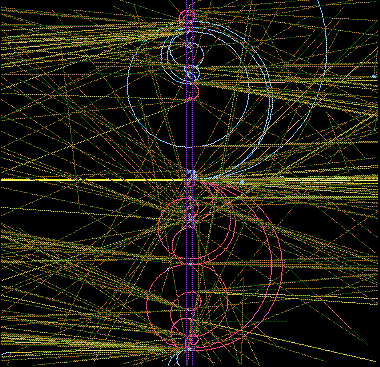
Shower...
In the description of gamma particles it was mentioned how electrons can create photons or gamma particles by interacting with a medium. In a similar way, photons can create electrons and their antiparticle, positrons, by interacting with a medium. So, imagine a very high-energy electron, of the sort used at SLAC impinging on some material. The electron will set photons into motion and these photons will set electrons and positrons into motion, these electrons will set other photons into motion and so on and so on. One high-energy electron can set thousands of particles into motion. Albert Einstein's famous relation governing the equivalence of matter and energy (Energy equals Mass times speed of light squared) rules this process as well. The particle creation process only stops when the energy runs out.
Since so many particles can be created from just a single initial
particle and the result looks like a shower of resultant
particles, it is given the name electron-gamma shower and this name
has attached itself to the computer code that can simulate it. Another
fancier name for the process is called the electromagnetic
cascade. The electro- part is pretty clear and cascade
is loosely another interpretation of shower. But, if you want
to know how magnets fit into this picture, you will need at
least a Bachelor's degree in physics.
(Hint: It has to do with Maxwell's equations that describes light as
an oscillating electric and magnetic field. I TOLD you you'd need a
physics degree to figure this one out!)
Here's a picture of a Monte Carlo
simulation of a 10 high-energy photons incident on a slab of lead in a
tank of liquid hydrogen. Electrons are blue, positrons are red and
photons are yellow. The trajectories of the electrons are being bent into
spirals by a magnetic field and electrons and positrons spiral in
opposite directions. Photons are not affected by magnetic fields.
Look at all the particles set in motion from just a few high-energy
photons!
